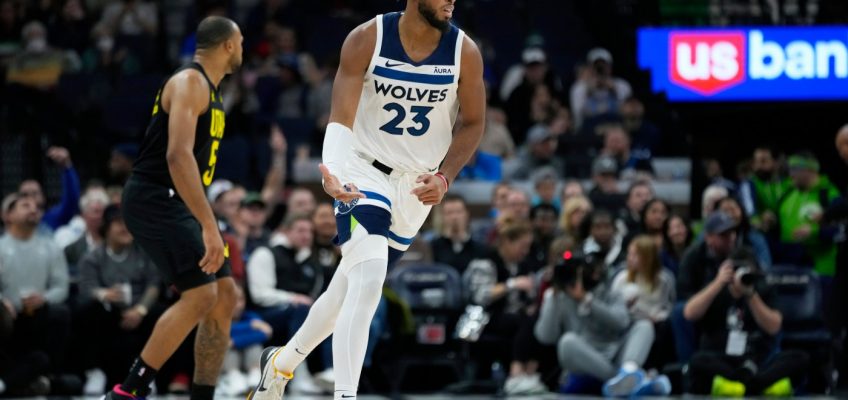Injured Anthony Edwards could return to the Timberwolves’ lineup as soon as Thursday in Dallas. That’s good news for a team in the midst of a difficult portion of its schedule and that showed in Monday’s loss in New Orleans that if it is to compete with some of the NBA’s most-talented teams — particularly on the road — it likely will need its best player to do so.
Edwards’ return would fill Minnesota’s boat re: roster availability after Jordan McLaughlin and Jaden McDaniels also returned to action within the past few days.
So Timberwolves coach Chris Finch will have the option to reshuffle the deck and dial up the rotation however he sees fit.
As a reminder, when the Wolves were healthy at the start of the season, the core rotational pieces were Edwards, Karl-Anthony Towns, Rudy Gobert, Mike Conley, McDaniels, Nickeil Alexander-Walker, Naz Reid, Kyle Anderson and Shake Milton, while Jordan McLaughlin was used in short stints as a spark when needed.
But things have changed since then. Minnesota’s bench has been uninspiring at times, and the injuries to his fellow wings have given Troy Brown Jr. opportunities for playing time, which he has seized.
So, when everyone is available upon Edwards’ reinsertion into the starting lineup, Finch will have 11 players who have seen playing time this season at his disposal. Realistically, only nine of those guys can play legitimate minutes.
There are eight locks for rotational spots, with Towns, Edwards, Gobert, Conley and McDaniels set to start — McDaniels came off the bench Monday in his return to action, but that’s often a method used to reintegrate players who are on a minutes restriction — and Alexander-Walker, Reid and Anderson coming off the bench.
Assuming Finch doesn’t extend his rotation, that leaves three guys vying for one spot. It’s possible that ninth spot will go to any one of the three depending on situations and matchups. For instance, if the second unit’s offense stalls out in the first half, McLaughlin, a floor general, could be asked to attempt to jumpstart the engine in the second half of the third quarter.
But McLaughlin, who has played well this season after struggling to return from a calf injury last spring, lacks the shooting and size Finch seems to want to round out the rotation, even though the second-unit’s offense appears to be at its best when the point guard is in the game.
The Wolves like to lean into their identity as a “big” team, and no one would use that word to describe the reserve point guard.
That McLaughlin only played sparingly Monday in New Orleans seemed to provide further evidence that he’s not in Finch’s immediate rotational plans.
Milton, on the other hand, has size. It seems Minnesota signed Milton this offseason with the vision that he would run the second unit. But that hasn’t gone according to plan, as Milton has struggled to find any sort of offensive consistency in half-court sets. He’s a fast-break player on a team that, frankly, thrives with slow pace.
The Timberwolves have been patient amid Milton’s slow start, but it could be time for tough decisions to be made.
Then there’s Brown Jr., who seemingly earned the trust of the coaching staff via his strong play. He has started recent games in which Edwards and McDaniels were both sidelined, and has played 25-plus minutes in each of the Wolves’ past five games. Brown checks boxes as a competent defender who can also hit enough shots to not hinder the offense.
It’s difficult to imagine Brown Jr. going from such a big role to being entirely out of the rotation when Edwards returns. Assuming Brown Jr. stills sees minutes, Alexander-Walker, Anderson and even Edwards will share point guard duties when Conley isn’t in the game as Minnesota continues to shift further and further toward “positionless basketball” with its reserve unit.
“I’ve always been pretty comfortable with it. A lot of teams I’ve been involved in going way back have had it,” Finch said last week. “Playing with pace, like giving freedom for different guys to bring the ball (up court) and then it’s literally about, you play out of these actions and maybe another point guard or a guard is bringing the ball that better suited for these actions. It’s creating a bit of a menu for that. It gives you some variety too. It’s not like you come down, do the same thing all the time. For me, it’s been comfortable, but your team still has to get used to playing that way.”
Related Articles
Timberwolves’ six-game winning streak snapped in New Orleans
Jace Frederick: For the Timberwolves, the next month is one massive test
Wolves rout Memphis, improve to NBA-best 17-4
Is this the best Rudy Gobert has ever played? No, Timberwolves center is just back to his dominant self
Jordan McLaughlin nearing his return to Timberwolves’ lineup, and confident he can hit the ground running


Leave a Reply